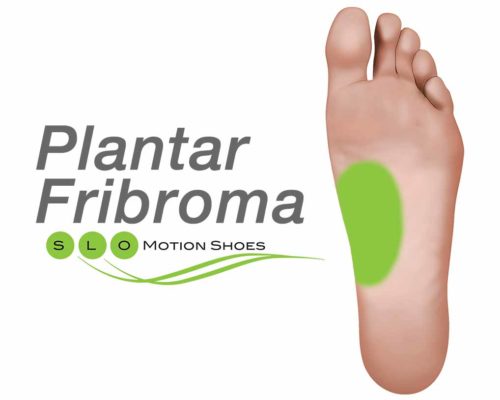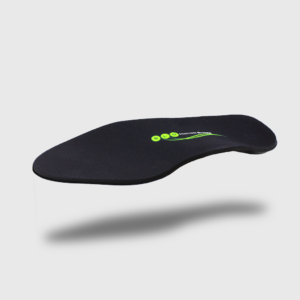Fibroma refers to a benign (non-cancerous) fibrous tissue growth, or nodule, that occurs in the body. Plantar refers to the bottom surface of the foot. A plantar fibroma typically occurs in the mid-arch area of the bottom of the foot deep within the tissue in the ligaments.

Symptoms
Lump in the arch of foot that feels firm to the touch
Slow-growing
May experience pain from pressure of shoe against lump
Pain sensation may be described as “sharp” or “tearing”
Usually occurs in one foot
Does not go away or get smaller without treatment
Measures less than one inch in size
Tissue over the lump appears normal
Causes
Cause is unknown
May be genetic
Possibly related to scar formation from micro tearing of the plantar fascia ligament
Associated with other conditions — alcoholism, medicine intake, and liver disease
Treatments
A plantar fibroma that is asymptomatic and not changing in size is often observed. Conservative measures may reduce pressure and pain. If lump increases in size and/or pain continues or worsens, surgical removal may be necessary.
Supportive shoe with orthotic arch support
Pressure relieving pads
Steroid injection
Plantar Fibroma
The arch located in the middle portion of the foot is an area that receives very little impact pressure during walking compared to the heel bone and the ball of the foot.
Impact pressures are of little concern but stress on the soft tissue of the arch can be. When looking at X-rays the bony architecture in conjunction with the walking surface forms a “triangle”. The “keystone” or the highest portion of the arch forms the peak of the triangle and receives a tremendous amount of mechanical stress during walking. The soft tissues including the ligaments, tendons and muscles of the arch are at risk for developing pain related to these stresses.
A Plantar Fibroma is a benign soft tissue mass generally occurring within the midarch region on the bottom of the foot. The soft tissue mass represents a thickening of the connective tissue within the plantar fascia ligament as it courses from the heel bone to the base of the toes. The soft tissue mass is generally characterized by non-painful nodularity to the ligament in the midportion of the arch. It is usually seen on one foot but can present on both. Its cause is not clearly understood.
Pain in the midarch related to mechanical stresses as well as plantar fibroma is usually worse with initial weight bearing. Pain to the arch can be sharp and “tearing” in sensation. A supportive shoe with an orthotic arch support will decrease the stress on the soft tissues of the midfoot.
Arch Pain
Plantar fasciitis is the most common cause of adult heel pain. It accounts for 10% of all foot and ankle healthcare visits to lower extremity healthcare specialists
The plantar fascia is a broad based ligament that originates from the bottom of the heel bone and fans out attaching to the base of the toes. Excessive mechanical stresses on the ligament can cause injury to the ligament at the level of attachment to the heel bone.
The “itis” in plantar fascitis denotes inflammation of this ligament as it attaches to the heel bone. Pain associated with this inflammation is noted typically to the bottom aspect the heel bone. Pain is typically worse with initial rising from a sitting position such as getting out of bed in the morning or pain noted after arising from a prolonged sitting period.
The cause of plantar fasciitis has much more to do with inherited foot mechanics and abnormal stress placed on the plantar fascia. Abnormal foot pronation which can cause increase stress to the plantar fascia appears to be one of the main reasons for developing this injury. One of the major causes of plantar fascitis is related to abnormal walking mechanics occurring during the “midstance” phase of the walking cycle. During midstance the foot is going through complex motion called pronation and supination. The pronated foot is a very flexible foot position that can accommodate abnormal walking surfaces while the supinated foot is a rigid state that prepares the foot to transfer the weight bearing pressures of the body into the swing portion of the walking cycle. Between the midstance and propulsive portion of the walking cycle the foot normally moves from a pronated position into a supinated position in preparation of lifting the foot off of the ground as it enters the swing phase of the gait cycle. People who develop plantar fascitis generally stay in a pronated foot position as the heel lifts off of the ground. This pronated position increases abnormal pressures on the plantar fascial ligament which can lead to the development of plantar fascitis.
Other contributing factors including non supportive shoe gear, poor conditioning while returning too quickly to athletic activity and excessive body weight have an influence in its development.
Treatment is geared at stabilizing abnormal foot pronation with supportive shoe gear and orthotic as well as decreasing inflammation and pain at the plantar fascial attachment site.
ShoeStabilizing the foot biomechanically and controlling abnormal foot pronation is performed by wearing a very supportive shoe and over the counter orthotic device. It is very important during the period of treatment to avoid all barefoot, slipper or use of sandals and open backed shoes even around the house. The goal is to wear shoes at all weight bearing times including getting out of bed in the middle of the night to go t the bathroom. The analogy is that of a fracture. Successful healing of a fracture involves the use of a cast at all times generally for a 4-6 week period of time. If motion occurs at the fracture site healing is delayed. Although plantar fascitis is a soft tissue injury it is treated by removing the weight bearing stresses on the soft tissues with the shoe and the temporary orthtoic.
OTC OrthoticWe generally recommend a supportive shoe like running shoe with a rigid heel counter, supportive midsole and lace up features as well as the addition of a firm arch support. There are many different arch supports that are commercially available but in general any arch support that is “firm” as compared to “soft” is preferred. The initial thought when the heel hurts is to get an arch support that is “soft” but remember the main use of the orthotic arch support is to decrease abnormal foot motion. Usually an over the counter arch support rather than a custom orthotic will be sufficient to help control abnormal foot pronation.
Plantar Fibroma Discussion Board
Select a View
Click on the view that most represents the area of discomfort that you are experiencing. Drag your cursor over your area of concern to obtain a brief description of the potential condition.
Suggested Product
-

Standard Orthotic
$60.00Our standard orthotic. Relieves pain and provides all day support.Select options







